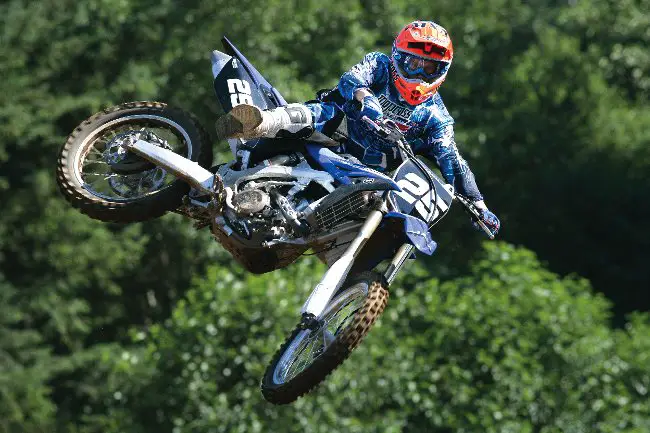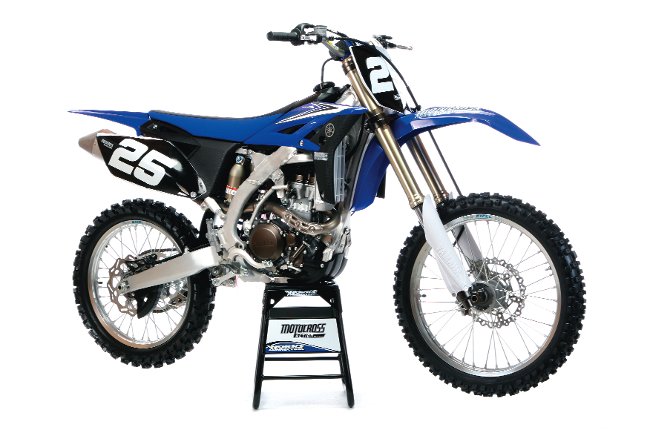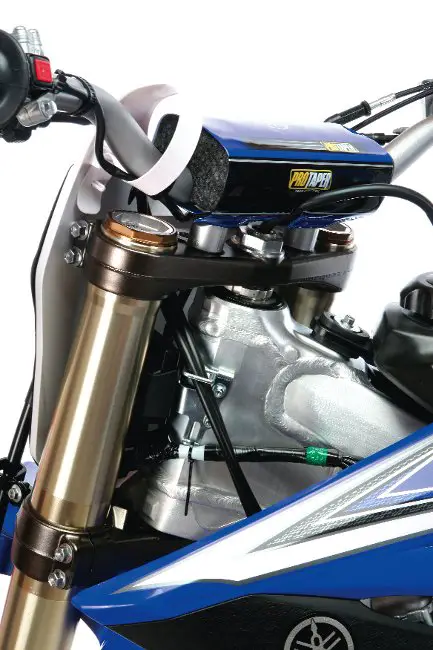REAL TESTS! 2010 MXA RACE TEST OF THE YAMAHA YZ250F:

Q: FIRST AND FOREMOST, IS THE 2010 YZ250F BETTER THAN THE 2009 YZ250F?
A: No. The scales of justice teeter back and forth because some aspects of the 2010 are much better than the 2009, but others aren’t. In the final analysis, we think the too short and too punchy powerband of the 2010 left it wanting.
Q: WHAT ARE THE MAJOR CHANGES THAT YAMAHA MADE TO THE 2010 YZ250F?
A: Let us count the ways.
(1) Metal forming. Yamaha switched to a bilateral beam frame for 2010 (bilateral frame is Yamaha’s nomenclature for a perimeter frame). The frame is built from 20 different pieces of forged and extruded aluminum as opposed to the 11 cast sections of the 2009 YZ250F frame. Forging and extruding creates tighter molecular structures than the previous castings.
(2) Frame rigidity. The frame’s spars have been designed to increase lateral and torsional rigidity while keeping the same vertical rigidity. The suspension is supposed to absorb the increased lateral and torsional rigidity. Yamaha has discovered that by dialing in the amount of twist along the frame’s horizontal plane can improve handling.
(3) Frame geometry. Yamaha moved the head tube 7mm back and 12mm lower than its 2009 position in an effort to create a more compact chassis. The goal? Move the rider closer to the front wheel, allow for quicker direction changes, and create a lightweight feel. The 2010 YZ250F retains the same 25mm offset triple clamps. The new frame is 100 grams heavier than the 2009 frame (that is about three ounces).
(4) Carburetor. In an effort to improve throttle response and bottom-end power, Yamaha moved the intake boot 10mm to the center, tapered and bored the venturi on the Keihin FCR MX37 carburetor, improved atomization and richened the jetting. There is also a new acceleration pump cam shape for quicker fuel delivery.
(5) Cylinder head. Along with a new cam profile (intake cam lift is changed from 7.6mm to 7.7mm for better low-end to midrange power), the valve stem ends have been chromium-nitride coated for improved durability. The valve spring retainers have been changed from steel to aluminum (aluminum weighs 30 percent less than steel), thus reducing the valve spring load. Valve spring pressure is lighter for reduced valve opening force. Additionally, the exhaust port shape is changed to a smaller area D-shape design. This reduces the exhaust port volume and helps draw exhaust gases out of the cylinder.
(6) Exhaust. In an effort to reduce noise, Yamaha lengthened the muffler by 50mm. The midpipe has two steps (from 45.0mm to 50.8mm) and the core diameter of the muffler has been reduced from 42.7mm to 41.3mm. The pipe’s perf core holes have been arranged in a pattern that is 1mm wider than previously (from 4mm to 5mm), and the muffler bracket is now solid mounted.
(7) Clutch. Three changes have been made to the clutch. First, the clutch actuation arm cam ratio has been increased by nine percent to make the clutch lever pull easier. Second, the clutch spring load has been increased by six percent for stronger engagement. Third, a harder material is used on the clutch basket center boss for improved durability.
(8) Gearing. Third, fourth and fifth gear have been strengthened for greater durability. The gear ratio on third and fourth gear is slightly taller, and the dog shape has been changed for more positive engagement. The different gear ratio equates to less than 1/2 of a tooth. Need an example? A 49-tooth rear sprocket from the 2009 YZ250F is now approximately a 48.7-tooth sprocket on the 2010 YZ250F.
(9) Oil tank. Yamaha decreased the size of the remote oil tank, and total oil capacity of the 2010 YZ250F has been reduced from 1300 to 1200cc. Yamaha claims that there is more oil circulating around in the engine and less stored in the oil tank.
(10) Radiators. Yamaha dropped the radiators by 15mm and moved them 10mm back on the frame. They also narrowed the radiators, but made the cross-section of each radiator thicker. The 2010 radiators have the same cooling capacity as they did in 2009.
(11) Forks. Kayaba SSS (Speed Sensitive System) forks come standard on the 2010 YZ250F, just as they have since 2006. Damping settings have been changed in an effort to keep plushness, but reduce the amount of stroke in high-load situations. Also on the KYB components is a new fork seat shape, new surface treatment on the piston rod, and steel protector sliders (formerly plastic).
(12) Shock. The steel Kayaba SSS shock spring has been moved 30mm lower on the shock body to create room for the straight intake tract to miss the spring retainer. The damping spec has also been changed to work in unison with the new chassis.
(13) Ergonomics. The handlebars feature four-way adjustable bar mounts and 5mm taller handlebar mounts. The 2010 YZ250F also has a new flatter seat shape and 5mm taller footpegs that allow the rider to move closer more freely on the bike.
(14) Gas tank. Yamaha redesigned the gas tank to fit in the perimeter frame. Its capacity was reduced by 0.6 liters. In previous years, the YZ250F shared the same gas tank as the YZ450F.
(15) Skid plate. Yamaha noticed that the stiffness of the old aluminum skid plate changed the frame’s rigidity. For 2010, they switched to a one-piece plastic skid plate (which doesn’t adversely affect frame rigidity).

Power elite: The 2010 Yamaha YZ250F is lightning quick out of the hole, but after 50 yards the engine is tapped out. It lacks top-end or noticeable over-rev.
Q: IS THE 2010 YZ250F FASTER THAN THE 2009 YZ250F?
A: The short answer is no. In a head-to-head comparison, the 2009 is slightly faster than the 2010 YZ250F across the entire range of the powerband. Directly off the bottom, the 2010 engine is much stronger. The new engine pulls harder for a shorter period of time, but once the rpm climbs, the 2009 YZ250F powerband feels more fluid. The difference between the two engines is not night-and-day, about a half horse on the dyno, but it means that the 2010 powerband is not superior to the 2009.
Q: HOW WOULD WE DESCRIBE THE 2010 YZ250F’S POWERBAND?
A: The 2010 Yamaha YZ250F is the Usain Bolt of motocross bikes. It is lightning quick out of the hole, but after 50 yards the engine is tapped out. To successfully ride the YZ250F you must shift quickly; otherwise you will stagnate while the competition passes you by. The 2010 YZ250F does its best work from low to mid, but lacks top-end or noticeable over-rev.
Q: HOW DOES THE 2010 YZ250F RUN ON THE DYNO?
A: Maximum horsepower on our 2010 YZ250F was 35.88 ponies at 11,500 rpm. Maximum torque was 18.95 foot-pounds. For comparison, our 2009 YZ250F reached 36.41 horsepower at 12,000 rpm and produced 19.19 foot-pounds of torque. For further comparison, the 2010 KTM 250SXF made 36.90 horsepower, the 2010 KX250F 36.48 horsepower and the 2010 CRF250 made 36.37.
All is not lost on the 2010 YZ250F engine, because from 6200 rpm to 6800 rpm the 2010 engine had a 1/2 horse-power advantage over the 2009 YZ250F, which plays into the low-to-mid profile. At 10,000 rpm, the 2009 YZ250F was more than a match for the 2010 model. We’re not shocked to discover that the 2010 YZ250F produced significant horsepower numbers on the bottom-end.
If you analyzed the changes they made, most of Yamaha’s 2010 engine modifications were designed to boost bottom-end power. We are, however, left scratching our heads as to why Yamaha focused so heavily on bottom-end power (from 6000 to 9000 rpm) instead of midrange (9000 to 11,000 rpm) or top-end (11,000-13,000 rpm).
Q: IS THE 2010 YAMAHA LIGHTER THAN THE 2009 YZ250F?
A: No. For 2010, the YZ250F is 1/4 pound heavier than the 2009 YZ250F. The weight increase comes from the frame and longer silencer. The additional weight is not noticeable on the track, nor when putting the bike on a stand.
Q: HOW IS THE 2010 YAMAHA YZ250F JETTING?
A: We had no issues with the newly richened YZ250F jetting, save for the normal fuel screw adjustments for weather conditions and altitude.
Mainjet: 180
Pilot: 45
Needle: NDJR
Clip position: 4th from top
Fuel screw: 3/4 turn out (1-3/4 turns out)
Leak jet: 70
Notes: Yamaha’s initial literature listed the fuel screw at 2-1/4 turns out, but Yamaha changed the fuel screw to 1-3/4 turns out for production. The needle is richer by a half clip compared to the 2009 needle. For high altitude, we recommend switching to a 178 mainjet with the clip in the 3rd position. For cold weather, we recommend swapping the 180 mainjet for a 182 and adjusting the fuel screw to 2-1/4 turns out.

Forks: We had some issues with the Kayaba SSS forks.
Q: HOW DOES THE 2010 YAMAHA YZ250F HANDLE?
A: Evidenced by their update to the frame in 2010 and their hydroformed swingarm in 2009, Yamaha was serious about improving the handling of the YZ250F. Have they succeeded? Yes. The 2010 YZ250F handles better than the 2009. The front end doesn’t understeer, and the chassis seems to handle braking bumps, ruts and jumps with relative ease. Every test rider was impressed with the improvement of the new chassis.
Q: WHAT WERE OUR BEST FORK SETTINGS?
The forks go about two-thirds of the way through their travel and then hit a harsh shelf of damping that brings them to a jolting halt. They will rattle your eye-teeth in braking bumps. This is the epitome of mid-stroke harshness. There is a fix, but it involves lowering the oil height.
For hardcore racing, these are MXA‘s recommended 2010 Yamaha YZ250F fork settings (stock settings are in parentheses).
Spring rate: 0.46 kg/mm (0.45 kg/mm)
Oil quantity: 330cc (350 stock)
Compression: 2 clicks out (8 clicks out)
Rebound: 8 clicks out (10 clicks out)
Fork leg height: 5mm up
Notes: Slower and smaller riders can get away with using the stock 0.45 kg/mm fork spring rate, but heavier riders (over 160 pounds) should jump up a spring rate. Once you go stiffer on the fork springs you can adjust the fork oil height to get the midstroke feel that you like best (we lowered the oil height by 20cc with the 0.46 springs). Lightweight riders will like the stock forks and springs better if they lower the oil height by 10cc.
Q: WHAT WAS OUR BEST SHOCK SETTING?
A: In stock trim, the Kayaba suspension isn’t very well balanced. Yamaha was close in their baseline settings, but the shock feels high in the stroke. We increased the race sag to 105mm (Yamaha recommends between 95-105mm). We slowed down the rebound and low-speed compression, but sped up the high-speed.
Spring rate: 5.3 kg/mm
Race sag: 105mm (100mm)
Hi-compression: 2-1/4 turns out (1-3/4 turns stock)
Lo-compression: 7 clicks out (9 clicks out)
Rebound: 9 clicks out (10 clicks out)
Notes: Riders who don’t need heavier fork springs should always run 105mm of sag.

Blast zone: The YZ250F is at its best on the torque curve.
Q: WHAT DID WE HATE?
A: The hate list:
(1) Powerband. We are still befuddled that Yamaha wanted more bottom-end power. We had hoped for a more powerful engine from 9500 rpm on up. Maybe next year?
(2) Forks. Hate is such a strong word, especially when referring to Kayaba SSS forks. The forks aren’t the worst we’ve ever tested, but the stock settings are way off. Heavier riders will need to invest in stiffer fork springs (and everyone should consider lowering the oil height, regardless of which spring rate they choose, to get rid of the spike in the mid-stroke).
(3) Side panels. Yamaha’s new side panels barely hold numbers.
(4) Gearing. In order to get the most out of the bottom-end power, we swapped the stock 49-tooth rear sprocket for a taller 48. Even so, it’s difficult to maximize the short powerband of the 2010 YZ250F.
(5) Front fender. The front fender looks funky, slaps against the front tire, wiggles at speed and retains mud in its crevices. Did we mention that it is ugly? Did we mention that it reminds us of the KTM front fender? Did we mention that we don’t like the KTM front fender either?
Q: WHAT DID WE LIKE?
A: The like list:
(1) Frame. The all-new 20-piece frame is stronger than last year’s frame, and has increased lateral and torsional rigidity. Those improvements add up to a better-handling chassis.
(2) Handlebar mounts. We liked the handlebar mounting options on the YZ250F.
(3) Footpegs. The 2-1/4-inch-wide titanium footpegs are lightweight and wide. They also refuse to pack up with mud. Very nice stuff.
(4) Bridgestone tires. We like the Bridgestone 403A/404 tire combo?especially the 403A front tire that was developed specifically for the YZ250F.
(5) Top steering bearing seal. In the past, the seal on the upper steering head bearing was suspect and would allow water to seep into the steering bearing, causing it to rust and lock up. Yamaha increased the thickness of the seal by 0.3mm. Good job.
(6) Sound. The longer muffler, reduced core diameter and increased perf-core-hole pitch equals a quieter exhaust system. Our YZ250F exhaust registered 95.5 dB (legal in AMA competition). Under AMA rules a bike can be 95.9 dB and still meet the 94 dB standards.
(7) Clutch. The clutch lever pull feels like butter. It’s smooth and simple to engage.
(8) Oil sight glass. In the past, the YZ250F oil sight glass was 200mm too high. For 2010, Yamaha put it in the correct spot. Kudos!
Q: WHAT DO WE REALLY THINK?
A: Yamaha made a leap forward by updating their frame, but the fork settings and powerband left us dismayed. We’re content with the 2010 YZ250F, but it isn’t outstanding in any specific category.






Comments are closed.